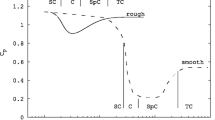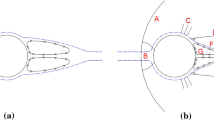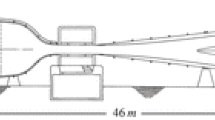Abstract
The bypass transition of flat-plate boundary layer induced by a circular cylinder wake under the influence of roughness elements is experimentally investigated. The hydrogen-bubble visualization results show that the boundary layer separation occurs upstream of the roughness, and the separated shear layer is incised by roughness to different extent, resulting in different kinds of secondary vortices formed immediately downstream of the roughness. During the evolution of the secondary vortex, two types of instabilities are observed, which are denoted as large- and small-scale instabilities, respectively, according to different spatial scale of the hairpin vortices formed afterward. A merging process of hairpin vortices is also observed when the secondary vortices undergo the small-scale instability, and a potential new transition control strategy based on the present observation is proposed.
Graphical Abstract











Similar content being viewed by others
References
Bakchinov AA, Grek GR, Klingmann BGB, Kozlov VV (1995) Transition experiments in a boundary layer with embedded streamwise vortices. Phys Fluids 7(4):820–832
Cossu C, Brandt L (2004) On Tollmien–Schlichting-like waves in streaky boundary layers. Eur J Mech B Fluids 23:815–823
Ergin FG (2005) Roughness induced transition. Dissertation, Case Western Reserve University
Fransson JHM, Brandt L, Talamelli A, Cossu C (2004) Experimental and theoretical investigation of the nonmodal growth of steady streaks in a flat-plate boundary layer. Phys Fluids 16(10):3627–3638
Fransson JHM, Brandt L, Talamelli A, Cossu C (2005) Experimental study of the stabilization of Tollmien–Schlichting waves by finite amplitude streaks. Phys Fluids 17(5):054110
Fransson JHM, Talamelli A, Brandt L, Cossu C (2006) Delaying transition to turbulence by a passive mechanism. Phy Rev Lett 96(6):064501
Kachanov YS, Tararykin OI (1987) Experimental investigation of a relaxating boundary layer. Proc Siberian Div USSR Acad Sci Ser Tech Sci 18(5):9–19
Morkovin MV (1969) On the many faces of transition. In: Wells CS (ed) Viscous drag reduction. Plenum Press, New York, pp 1–31
Morkovin MV (1984) Bypass transition to turbulence and research desiderata. In: Transition in turbines. NASA Lewis Research Center, Cleveland, pp 161–199
Pan C, Wang JJ, Zhang PF, Feng LH (2008) Coherent structures in by-pass transition induced by a cylinder wake. J Fluid Mech 603:367–389
Piot E, Casalis G, Rist U (2008) Stability of the laminar boundary layer flow encountering a row of roughness elements: biglobal stability approach and DNS. Eur J Mech B Fluids 27:684–706
Tani I, Komoda H (1962) Boundary layer transition in the presence of streamwise vortices. J Aerosp Sci 29:440–444
Tomkins CD, Adrian RJ (2003) Spanwise structure and scale growth in turbulent boundary layers. J Fluid Mech 490:37–74
White EB (2002) Transient growth of stationary disturbances in a flat-plate boundary layer. Phys Fluids 14(12):4429–4439
Zhang C (2009) Experimental investigation of the effect of roughness elements on boundary layer bypass transition. Dissertation, Beijing University of Aeronautics and Astronautics, Beijing (in Chinese)
Acknowledgment
This research was funded by National Natural Science Foundation of China under grant number 10832001.
Author information
Authors and Affiliations
Corresponding author
Rights and permissions
About this article
Cite this article
Wang, J.J., Zhang, C. & Pan, C. Effects of roughness elements on bypass transition induced by a circular cylinder wake. J Vis 14, 53–61 (2011). https://doi.org/10.1007/s12650-010-0063-9
Received:
Accepted:
Published:
Issue Date:
DOI: https://doi.org/10.1007/s12650-010-0063-9




